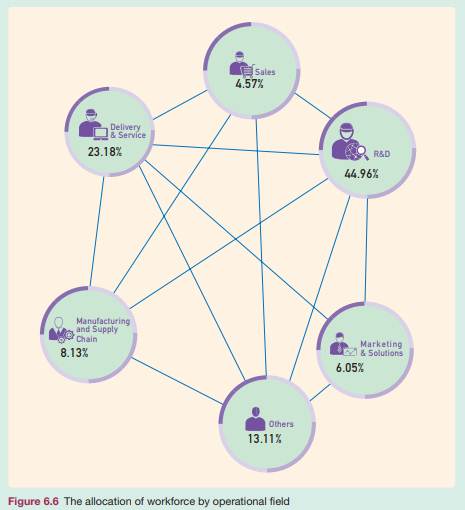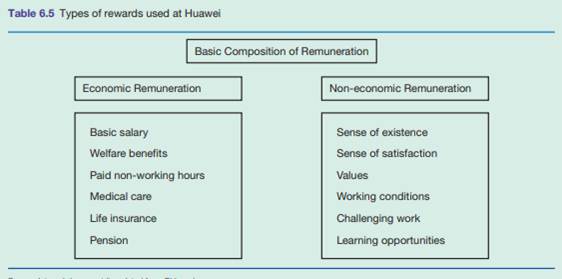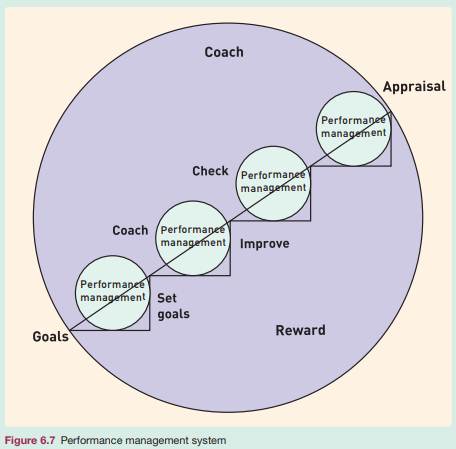REWARDING INNOVATION AT HUAWEI THOMAS A. BIRTCH AND FLORA F. T. CHIANG
Company background Huawei is a global leader in the information and communication technology (ICT) industry. Founded in 1987, it is a private company wholly owned by its employees.2 The company has grown from a small start-up based in Shenzhen, China to become a leading global technology company providing telecom network equipment, IT products and solutions and smart devices for telecom carriers, enterprises, and consumers in over 170 countries. In 2015 Huawei ranked 228th in the Global Fortune 500 index based on revenues of approximately CNY 288,197 million (USD$ 45 billion). It is now the largest supplier of telecom infrastructure
, software, and services in the world and its, major competitors include Ericsson, Nokia, ZTE, Alcatel-Lucent and Cisco (The Economist, 2012, 2014; Reuters, 2014). As illustrated in Figure 6.4, Huawei emphasises innovation relevant to customer needs and advancingits technological leadership through research and development (R&D). Over 10 per cent of the company’s annual sales revenue is invested in R&D, an activity that employs more than 45 per cent of its 170,000 employees. The company openly cooperates with its industry partners to build efficient and integrated digital logistics systems that enhance interconnectivity and interactivity and strives to be the ‘first choice and best partner’ for telecom carriers and enterprise customers and a brand of choice for consumers. An advocate of sustainability, the company supports the development of secure and stable network operations and helps customers and industries improve efficiency and low-carbon economic growth. According to Huawei, its international growth strategy, promoting ‘glocalized’ operations, aims to localise its operations in the countries it operates, whilst simultaneously building a strong global value chain.

Core values According to Huawei, it succeeds through its ‘customers’ success’. Serving customers and responding to their needs represents a major driving force behind its growth and development. Moreover, the long-term value it creates for its customers is used as a yardstick to gauge its work and performance. Figure 6.5 summarises Huawei’s core values. Research & development R&D at Huawei emphasises the development and innovation of key ICT technologies, architecturesand standards. According to its 2014 Annual Report, the company employed over 76,000 product and solution R&D professionals worldwide and invested 14.2 per cent (CNY 40,845 million) of its revenues for the year into R&D. The company operates approximately 16 R&D centres, including in the US, Germany, Sweden, France, Italy, Russia, India, and China, works closely with industry partners, academia, and research institutes and has 28 joint innovation centres with leading carriers. By the end of 2014 Huawei had joined more than 177 industry standards organisations, filed 72,636 patent applications of which 38,825 had been

granted, had invested a total of CNY190 billion in R&D over the past decade and had become a Top 100 Global Innovator. Human resources Huawei considers, its employees its ‘most valuable treasure’ and the key to retaining competitiveness and a leadership position. Employee health, safety, and benefits are priorities. The company believes that it provides reasonable and timely rewards to dedicated employees. In 2009 the company began transforming its human resource model from a ‘function-based platform’ to an ‘employee-centric platform’, which it argues better promotes employee development. As Figure 6.6 depicts, the dominant operational activity of Huawei’s workforce is R&D.
To complement its growth strategy, Huawei fosters the development of local talent in each country it operates. Its recruitment policy encourages sourcing talent locally and compliance with local labour laws and regulations. As of 2015 Huawei employed approximately 30,000 non-Chinese staff from over 160 countries and regions around the world. Reward management Huawei describes its reward system as competitive and aims to attract and retain high quality human resources to support and accelerate the company’s development and growth (i.e. a market leading remuneration strategy). As Table 6.4 illustrates, the company’s reward strategy has evolved in several phases since its founding.


Underscoring the company’s reward philosophy and practices, Hu Houkun, Rotating CEO, stated that, ‘In 2014, to strive for excellence, we raised salaries and incentives for operational units in the field and high-performing employees. We fully implemented the “Contribute and Share” mechanism for annual bonus. Regarding long-term incentives, we rolled out the Time-based Unit Plan (TUP) globally so that all outstanding employees, especially those at the junior and middle levels, could share in more of the benefits of the company’s medium-to-long-term development. In 2015, we will continue to incentivize performance.
We will step up efforts to provide more differentiated and targeted incentives to better motivate employees. While increasing monetary incentives, we will further extend the range of our non-monetary incentives, including awards such as “Whiz Kids” and “Future Stars”. We must provide high-performing employees with access to fast-track promotions, with regard to both positions and job levels, so that they get more development opportunities and rewards. Opportunities and rewards will also be used to attract talented people, including outstanding former employees, to join our team. Mechanisms must be put in place to ensure outstanding people can be brought in, engaged and retained. We will continue to care for employee health and happiness, with more focus on their overall wellbeing. We will also continue to build a world-class workplace, with improved recreation and dining facilities.” (5 January 2015) Table 6.5 provides a summary of the types of rewards used by Huawei. In general, the company pays higher

than market average wages and employs major international pay and compensation specialist consulting firms to regularly monitor and advise on pay conditions and best practices in the market. For example, the HR Department utilises compensation data from the Hay Group, Mercer, Aon-Hewitt, and other consulting firms to regularly adjust employee compensation and its compensation plan in an effort to strike a balance between market competitiveness and the cost of rewards. To develop its employees, Huawei offers a range of opportunities for learning, training, and promotion as well as two distinct career development paths – management and technical/professional. In addition to a comprehensive eLearning platform, Huawei operates 45 training centres globally that provide training services in 16 different languages, including English, Spanish, French and Russian. Both general learning and development programs and crossfunctional professional capability development programs are provided to increase employee knowledge and expertise.
In order to promote employees’ personal growth and development, the company also regularly sends its employees overseas for further study and training and has established an internal certification system (e.g. Huawei Certified Network Engineer). Additionally, to increase employees’ commitment to the development of skills, the company links training with pay and promotion. For example, the ‘Huawei Science and Technology Fund’ encourages researchers to innovate and start new projects and rewards the most productive researchers with promotions, better facilities and improved working conditions. In 2013 average training amounted to approximately 37.29 hours per employee. Employee bonuses are closely linked to overall company performance, the performance of an employee’s department and an employee’s individual performance. A long-term incentive mechanism is used in an attempt to share benefits with employees worldwide and align the personal contributions of employees with the company’s long-term development.
Huawei provides non-monetary incentives that emphasise three areas (health, development and relationships), including the working environment and emotional care, and promotes work–life balance through family days and other activities. Lastly, its employee benefits system provides a safety net for all employees and includes, mandatory and commercial insurance (e.g. personal accident insurance, critical illness insurance, life insurance, medical insurance, business travel insurance) and defined contribution retirement plans.
Rewarding Performance Huawei has implemented a results-oriented performance management system to support its business strategy. Goals are set for employees and adjusted on a regular basis. As illustrated in Figure 6.7, by continuously setting goals, coaching, appraising and communicating, managers help employees improve their performance and capabilities
. As part of its performance management system, 3 to 5 per cent of Huawei’s employees are laid off annually and it is common practice for the salaries of other poor performers to be reduced. Incentives and awards Huawei uses a variety of incentives to motivate its employees. An Award Department was established to oversee the evaluation and distribution of awards. There are two features of the awards. First, they cover a wide range of performance outcomes. For example, as long as employees make some distinctive work progress or achievement (e.g. the completion of a project, research achievements) they will obtain an award. Second, all awards are cash based and there is no set limit to the amount of awards. As a consequence, big achievements are eligible for substantial financial awards. Long-term incentives Huawei no longer offers direct ownership of the company to its junior and middle levels employees. Instead, it has begun to implement a profit-sharing and bonus plan based on employee performance for all eligible employees, which it labels the TUP. According to its 2014 Annual Report, “Under the TUP, time-based units (TBUs) are granted to the recipients, which entitle the recipients to receive a cash incentive calculated based on the annual profit-sharing amount and the cumulative end-of-term gain amount. Both of the annual profit-sharing and the end-of-term gain amount are determined at the discretion of the Group. The TBUs will have an exercise period of five years, and after the first, second and third anniversary of the date of grant, each one third of the TBUs will become exercisable and recipients will receive the annual profit-sharing amount accordingly. The end-of-term gain amount will be paid to the recipients upon the expiry of the TBUs or at the date the recipients resign or are dismissed. As at December 31 2014, the valid TBUs granted were 1,051,400,894 units; liability and the corresponding personnel expenses have been recognised in respect of 385,160,827 units of the valid TBUs.” (p. 79)

Table 6.6 summarises the proportion of different types of remuneration allocated at Huawei according to position. Huawei’s annual personnel expenses by compensation type for the 2014 fiscal year are summarised in Table 6.7. Criticism and obstacles facing Huawei Despite its success, considerable controversy surrounds Huawei’s competitive practices, organisationaculture, and reward practices (The Wall Street Journal, 2014; Financial Times, 2014; The Economist, 2012). For example, in addition to ethical questions over its competitive practices and concerns that its products may pose national security risks (e.g. in the US). Huawei has also been criticised for its extreme workloads and excessive employee overtime. According to employees, it is normal to work until 3 o’clock in the morning and then return to work the next day


by 9:00 am. Some employees even find it necessary to sleep in the office (what has become known as a “mattress” culture). The company has even been accused of making ‘overtime’ mandatory (e.g. a component of performance evaluations). As a result, employees feel compelled to forgo holidays and annual leave and to work considerable periods of overtime to avoid sanction or poor performance evaluations. Huawei has also been criticised for its lack of transparency in relation to various reward practices, including the implementation of its stock option scheme and the employee evaluation process. For example, although the company claims to be wholly employee owned, it remains unclear about the actual extent to which employees actually own the company. Moreover, employees do not have a voice in management decisions and foreign employees are not eligible to hold company shares.3 Lastly, as discussed above, Huawei’s performance management system leads to 3 to 5 per cent of employees being laid off annually. However, the system has been criticised for targeting older employees in favour of cheaper newly-hired graduates and for adversely affecting employee morale.
Questions
1 How would you characterise the alignment between Huawei’s business strategy, core values and reward practices?
2 Huawei’s competitive strategy emphasises R&D and the development of innovative capabilities. What are the advantages and disadvantages of its current reward management practices in relation to such a strategy?
3 Would Huawei’s reward system be appropriate if the company’s business model were any different (e.g. a low cost strategy)?
4 Is Huawei’s reward management framework appropriate for rewarding and incentivising its R&D professionals. What changes should be recommended, if any?

